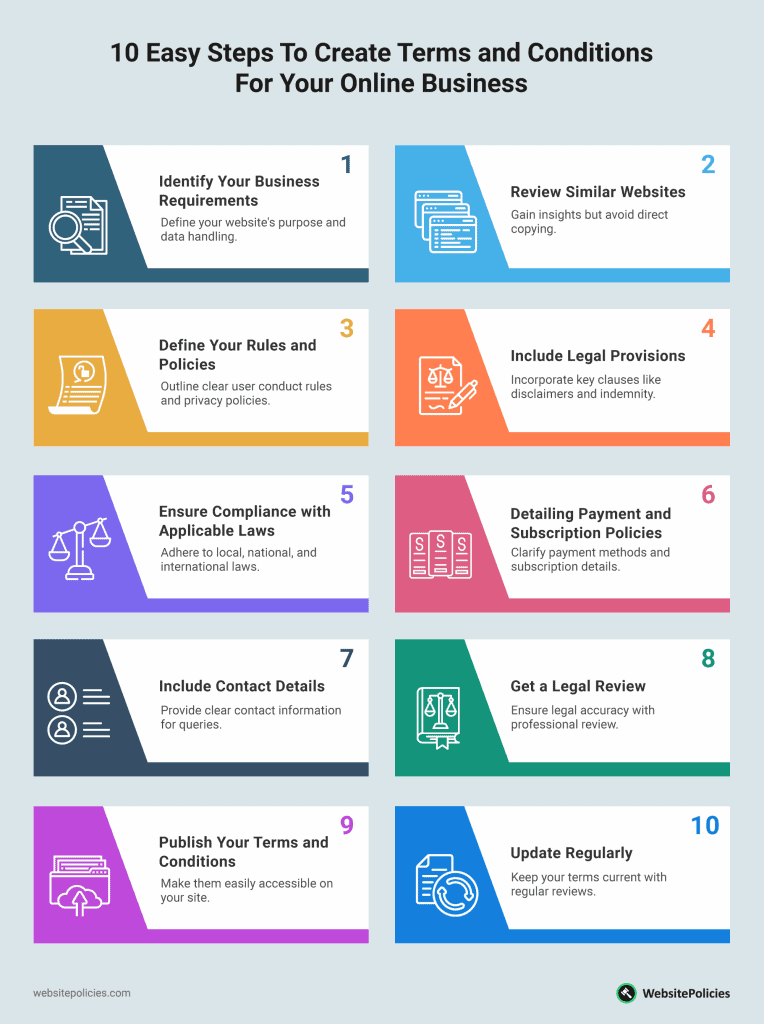Ever thought about the importance of terms and conditions for your website? Most people see it as just another legal document, but it’s actually an important element to protect your business and create a smooth user experience.
In this article, I’ll walk you through the essential steps on how to write terms and conditions for your website, discuss key elements to include along with some of the best practices, and give you some other options that may work better for you if you want to save time.
- Writing website terms and conditions involves identifying business requirements, defining rules and policies, ensuring legal compliance, and regular updates for changes.
- User-friendly terms and conditions use simple language, are organized, transparent, displayed prominently, and contain realistic and enforceable terms.
- Alternatives to doing it yourself include hiring a lawyer (costly but thorough), using online generators (fast and affordable but varying quality), or using a template (risks include varying quality and potential copyright issues).
Table of Contents
PRO TIP: Take the hassle of writing your own terms and conditions away with our terms and conditions generator trusted by over 200,000 businesses. It’ll save you hours of work and possible costly legal mistakes.
How to Write Terms and Conditions in 10 Steps
As online business owners, having robust terms and conditions is an essential requirement for your online presence. It’s the contracts that govern the use of your website, or any products or services which may be found therein.
Given its importance, this document should not only protect your business but should also clearly communicate to your users or customers your guidelines for acceptable behavior and conduct when they use your website or your services.
Here are 10 steps you can follow to create a legally enforceable terms and conditions agreement personalized to your specific business needs.

1. Identify Your Business Requirements
Firstly, understand and clearly define the purpose of your website. What services does it offer? What kind of data does it collect from users? Do you sell products or services?
Answering these questions will help you identify your needs and shape the terms and conditions accordingly.
This step is essential because it helps to outline the content that will be included in your terms and conditions. For instance, if you sell products, you might need clauses about delivery, returns, and refunds.
2. Review Similar Websites
Look at the terms and conditions of similar websites in your industry. This will give you a sense of what issues they cover and how they structure their agreements.
While you should never copy another website’s terms and conditions as they may be copyrighted, you can use them for inspiration and to ensure you’re not missing any significant issues.
Be aware that you must not rely on them. It’s meant to help you understand common practices in your industry, but your terms and conditions need to be tailored to your specific business and location.
3. Define Your Rules and Policies
Based on your requirements, start outlining the rules for your website. You might include sections on user conduct such as what is and isn’t allowed, registration and account security, payment terms if applicable, copyright and intellectual property policies, and privacy policies.
This step is about drafting the core of your terms and conditions. Make sure these rules are clear and easy to understand, as this will reduce the likelihood of misunderstandings later.
PRO TIP: To make things easier, you may consider using a terms and conditions template as your starting base as it’ll save you time.
4. Include Legal Provisions
There are several key legal clauses that should be included in most terms and conditions, such as disclaimers of liability and indemnity clauses.
The former limits your responsibility for issues such as inaccuracies in content or problems resulting from third-party links, helping to protect your business from potential legal action.
Meanwhile, indemnity clauses shift some of the risks to the users, stating that they will compensate you for any losses they cause, for example, through the misuse of your site.
Other essential provisions include dispute resolution procedures, which establish a framework for resolving disagreements, potentially favoring arbitration over court proceedings, and often specifying a jurisdiction for these processes.
Alongside this, a governing law clause identifies the specific jurisdiction whose laws will govern the agreement, adding a level of predictability.
Lastly, a severability clause ensures that if any portion of the agreement is found to be unenforceable, the rest of the agreement will remain in effect.
PRO TIP: This is a complex area, and it’s imperative to get it right, so it’s a good idea to either do proper research here or use a professional terms and conditions generator to avoid making mistakes and get everything covered.
5. Ensure Compliance with Applicable Laws
Your website does not operate in a legal vacuum. Depending on your geographical location, the nature of your services, and your user base, you’re subject to a variety of laws and regulations at the local, national, and sometimes even international levels.
These can include consumer rights laws, intellectual property laws, and many more.
For instance, consumer protection laws may dictate what you can and can’t do, and what you must disclose to consumers. You might also be required to provide clear information about pricing, delivery, returns, and refunds.
Failing to comply with laws can result in significant fines, lawsuits, or other penalties. You need to understand your legal obligations and ensure that your terms and conditions are in compliance.
6. Detailing Payment and Subscription Policies
If your website involves financial transactions, it’s essential to clearly articulate your payment and subscription policies. This should include specifying accepted payment methods, detailing the billing cycles, and clearly explaining any fees or charges that may apply.
Transparency in this area is key to avoiding misunderstandings and building trust with your users, especially when it comes to subscription renewal procedures and cancellation processes.
Providing clear, easily understandable information on these topics helps in managing user expectations and ensures a smoother operational flow for both the website owner and the users.
7. Include Contact Details
Having contact details displayed in your website’s terms and conditions is a good idea most people omit. It’s about being open and honest with the people who use your site.
If they have any questions or worries about the rules they have to follow on your site, they know who to talk to. And if there’s a problem or disagreement, they know where to go for help.
By sharing your contact information, you’re showing users that you’re ready to listen and that you value what they have to say. This can make them feel more comfortable using your site and make them think more highly of your business.
8. Get a Legal Review
Once you’ve drafted your terms and conditions, you may choose to get them reviewed by a lawyer depending on the complexity of your business or if you’re in the regulated industry.
This will help you ensure they are legally sound, comprehensive, and tailored to your business.
Your lawyer can also help you refine the language and ensure you haven’t missed any key issues. This step can help you avoid legal problems down the line though be prepared to spend some money.
9. Publish Your Terms and Conditions
Once your terms and conditions are ready, it’s time to add them to your website. This is probably the easiest step of all, isn’t it?
Make sure they are easy to find – commonly, they’re linked at the bottom of every page.
Another helpful step is to get users to agree to your terms and conditions when they register for an account or make a purchase.
This will further acknowledge their acceptance of the terms and avoid situations when they claim they didn’t see them.
10. Update Regularly
When things change, you need to make sure your terms and conditions still make sense and cover everything they need to. This helps to keep you and your users protected.
Your website might offer new features or services, or maybe you start collecting different types of information from your users. Laws that you need to follow can also change, especially if you have users from different parts of the world.
Regular reviews make sure that everything is up to date and that you’re still following the law. It also shows your users that you’re responsible and you care about their rights.
So don’t forget to regularly review and update your terms and conditions to ensure they remain current.
A Faster Way to Write Your Terms and Conditions Agreement
While writing your website’s terms and conditions by yourself can save you some money, it certainly is very time-consuming and presents some high risks.
Unless you have a legal background, there is a big chance that you lack the legal knowledge and familiarity in order to ensure that your agreement is legally binding.
Even if you invest the required time to really carefully construct your agreement, you may still end up with a non-enforceable document, or a document that is ill-equipped to protect your rights, especially if you do not understand the legal implications or what should be included. So what’s the solution?
Try our terms and conditions generator is an easy, fast, and reliable option. It can personalize the terms to your website and your specific business needs based on the answers you provide, all in a matter of minutes.
Unless you’re a large corporation with unique legal requirements or happen to operate in a regulated industry, this option is suitable for most online businesses.
PRO TIP: If you’re worried about the results, have a lawyer review your generated terms and conditions agreement. It will be much cheaper than paying them to draft it from scratch and will give you peace of mind.
Frequently Asked Questions
What are the advantages of using an online terms and conditions generator?
Online generators are fast, affordable, and can provide legally binding, customized agreements. Some even offer ongoing updates to keep up with changes in laws. However, quality can vary between generators so do your research.
How detailed should my terms and conditions be?
Your terms and conditions should be detailed enough to clearly define your user expectations and protect your business, but not so complex that your users can’t understand them.
Is hiring a lawyer necessary to create terms and conditions?
It’s not always necessary, especially for small businesses or non-regulated industries. Hiring a lawyer can be costly and time-consuming, and funds may be better spent on growing the business.
Can I copy the terms and conditions from another website?
No, it’s not recommended for your to copy from another website as they are specific to each business’s needs and operations.
Are all terms and conditions agreements the same?
No, all terms and conditions agreements are not the same. They vary depending on the company, service, or product, and they outline the specific rules, obligations, and limitations that are different as well.
How often should I update my terms and conditions?
It’s wise to review and update your terms and conditions at least once a year or when launching new features, or products, or in response to new laws.
What if a user violates my terms and conditions?
If your users violate your terms and conditions, you can take actions like suspending or terminating their accounts, depending on the severity of the violation.



